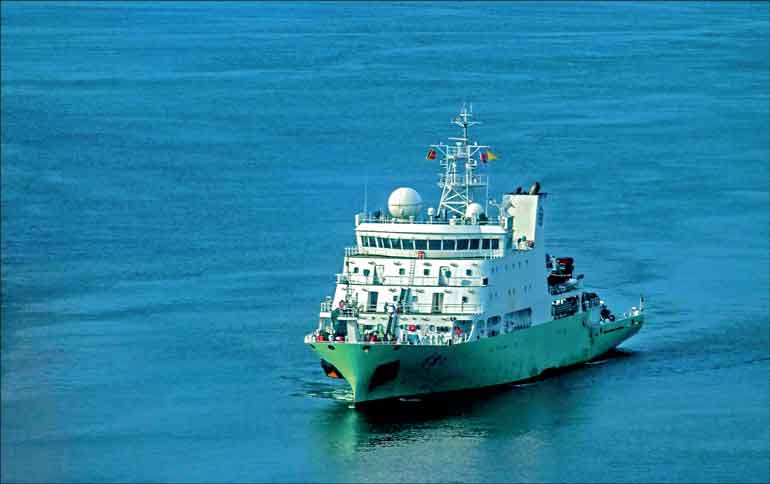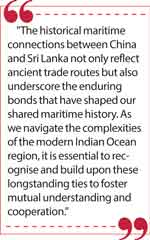Monday Apr 21, 2025
Monday Apr 21, 2025
Monday, 22 April 2024 00:20 - - {{hitsCtrl.values.hits}}

 China, a maritime power in the South China Sea and the Indian Ocean in the 14th century, has now undertaken a substantial expansion of its maritime infrastructure and naval fleet, poised to rival the strength of the U.S. naval fleet in the years ahead. In contrast to the United States, which exerts control over approximately 750 bases in 80 countries and surpasses the combined military expenditures of the next 10 nations, China's military spending and global naval presence remain comparatively restrained.
China, a maritime power in the South China Sea and the Indian Ocean in the 14th century, has now undertaken a substantial expansion of its maritime infrastructure and naval fleet, poised to rival the strength of the U.S. naval fleet in the years ahead. In contrast to the United States, which exerts control over approximately 750 bases in 80 countries and surpasses the combined military expenditures of the next 10 nations, China's military spending and global naval presence remain comparatively restrained.
The roots of Chinese naval engagement in the Indian Ocean can be traced back to ancient times, reflecting a longstanding maritime tradition. Evidence suggests that Chinese ships frequented ports in Sri Lanka over the centuries, artifacts such as Chinese coins and porcelain pottery found at major ancient ports in Anuradhapura and Polonnaruwa kingdoms testify to the enduring maritime ties between China and Sri Lanka. These historical interactions laid the foundation for future engagements and shaped the geopolitical landscape of the Indian Ocean region.
Records indicate that Chinese sailor Wang Dayuan, a naval explorer from Yuan Dynasty who was born in Hongzhou which is the present-day Nanchang, Jiangxi Province, reached ancient Sri Lanka in 1328-1333, a century before the renowned Admiral Zheng He’s treasure voyages, records also mentions that Wang Dayuan sailed to Australia around 500 years before James Cook. This early connection laid the groundwork for a deeper exploration of cultural intersections between the two regions that contributed to Chinese-Sri Lankan cooperation along the Silk Road. As early as the 14th century, the well-known expeditions of Admiral Zheng He, visits to ancient Sri Lanka several times, during the Kotte Kingdom further highlights the ancient maritime hub status of Sri Lanka.
In recent times, propelled by China's economic growth, its naval activities have enhanced. The geopolitical complexities surrounding the South China Sea, coupled with rivalries between India-China and U.S-China, have brought increased attention to the presence of Chinese state-owned vessels in the Indian Ocean by regional states and the mainstream media.
Sri Lanka's distinctive port structure, featuring three deep ports strategically located to the east, west, and south, could raise security concerns for neighbouring India. Nevertheless, since the initiation of the Indo-Lanka Agreement in 1988, India and Sri Lanka have upheld a security pact. By this agreement, Sri Lanka to consider Indian security interests in its affairs, over the years this security pact has further strengthen and India began to interpret the security pact in various other issues.
Amidst these developments, India, bolstered by increased confidence in global affairs following the events of COVID and the Ukraine-Russia conflict, has asserted itself as a global leader. The escalating complications on the India-China border have prompted a firm stance from the Indian government, particularly during Indian election times when regional conflicts are strategically provoked to garner political support.
Despite collaborative efforts between Sri Lanka and China in various maritime activities, suspicions arose when the Chinese research vessel Yuan Wang 5 arrived in Hambantota port in 2022. Indian concerns regarding the purpose of Chinese research vessels in Sri Lankan ports have added complexity to the bilateral relationship, especially considering the increasing maritime cooperation between Sri Lanka and China in recent years. China's well-equipped research vessels, viewed suspiciously by geopolitical rivals as potential cover for 'spying' missions, have raised concerns in the context of Sri Lanka's strategic location in the Indian Ocean. Speculation regarding China's interest in the Hambantota Port as a potential military base gained traction, particularly following a report by the organization AidData in 2022 suggesting the possibility of a Chinese military base in Hambantota.
The aftermath of the Yuan Wang 5 visit underscored the complex dynamics and delicate balance of power in the Indian Ocean region. It prompted not only increased vigilance on subsequent Chinese vessels by India, but also ignited a broader discourse on the implications of foreign research vessels in Sri Lankan ports, with far-reaching consequences for regional security and diplomatic relations.
The intricate dynamics surrounding the flexibility of Chinese research vessels arriving at ports, particularly in the context of the visit of Yuan Wang 5 to Sri Lanka in 2022, evoke a multifaceted analysis within the framework of international law. Key considerations involve the United Nations Convention on the Law of the Sea (UNCLOS) and its pertinent clauses, with Sri Lanka, India, and China presenting distinct perspectives.
Firstly, Sri Lanka asserts its sovereignty, emphasising that external pressures should not dictate decisions regarding the entry or denial of vessels to its ports. This aligns with the fundamental principle of freedom of navigation in international maritime law, as outlined by UNCLOS, allowing all nations, including China, unrestricted passage through territorial waters.
India, however, expresses concern over research activities in the Indian Ocean, citing national security interests. Drawing parallels with the historical U.S. Monroe Doctrine, India appears to be extending its regional influence, mirroring past American control over continental waters. The need for a transparent mechanism to ensure the "innocent passage" of Chinese vessels and safeguard Indian security becomes a pivotal consideration for Sri Lankan authorities.
 China finds itself in a complex legal position, with unresolved issues in the South China Sea and recent events in the Indian Ocean, Chinese research vessels were questioned to prove its self to adhere to principles such as "innocent passage" when arriving at foreign ports to avoid potential legal implications. In light of these complexities, the aftermath of Yuan Wang 5's visit underscores the significance of various international legal aspects.
China finds itself in a complex legal position, with unresolved issues in the South China Sea and recent events in the Indian Ocean, Chinese research vessels were questioned to prove its self to adhere to principles such as "innocent passage" when arriving at foreign ports to avoid potential legal implications. In light of these complexities, the aftermath of Yuan Wang 5's visit underscores the significance of various international legal aspects.
In light of these circumstances, Sri Lanka faced an economic crisis in 2022, leading to prompt financial assistance from the Indian government totalling around $4 billion. Leveraging this commitment and emphasizing Chinese lending as a factor in Sri Lanka's economic crisis, India has gained political influence within the Sri Lankan government in recent years.
Exploiting this influence, India has strategically expanded its reach into various sectors to maintain and strengthen its influence in Sri Lanka. Key areas of Indian investment include the energy sector, the India-Sri Lanka power grid connection, the India-Sri Lanka linking sea bridge, energy agreements, ferry service, and the implementation of an Indian payment system in Sri Lanka, among others, will further accelerate after the upcoming Indian elections.
In response to concerns India and the U.S. raised regarding Chinese research vessels in Sri Lankan ports, the Sri Lankan government has taken proactive measures. It announced the development of a "Stranded Operational Procedure" for ‘all research category ships’ entering Sri Lankan ports, along with establishing a local hydrography unit to conduct research independently. These initiatives underscore Sri Lanka's commitment to addressing the complications arising from the presence of Chinese research vessels while maintaining a balance in its regional relationships.
In response to the escalating global power dynamics in the Indian Ocean, certain military and government officials in Sri Lanka have proposed the strengthen the local hydrography unit. This initiative aims to enable Sri Lanka to conduct independent research in its regional waters, providing the government with enhanced negotiating leverage and allowing the nation to maintain a neutral stance.
In a recent interview with China’s state-run TV CGTN, Sri Lankan President Ranil Wickremesinghe referred to Chinese research vessel Shi Yan 6, stating that Sri Lanka was open to collaboration in the field of marine research “with all parties”, this hints at the nation's commitment to exploring ways to ensure ‘freedom of navigation’ in the Indian Ocean, reaffirming Sri Lanka’s stance on fostering cooperation while safeguarding its sovereignty and interests.
However, India is a major power in the region and Sri Lankan diplomatic channels agree that there is no stable growth in Sri Lanka without proper relations with India. Moreover, compared to other regional nations, Sri Lanka is one the only nations to maintain balanced relations with all regional nations in the Indian Ocean, including Pakistan, Maldives, India, China, and the Western countries. It’s no longer a secret that the geographic location of Sri Lanka has significant security implications for India and the U.S and the ultimate ambition of the United States extends to strategically positioning Sri Lanka as a central player in the region, akin to Taiwan’s role in the Pacific Ocean, Cuba’s significance in the Atlantic Ocean, and São Tomé and Príncipe’s role in the Gulf of Guinea. In such a narrative, a divided Indian Ocean would be more strategically important to the U.S., and as the regional nations in the Indian Ocean grow more disparity, the U.S. will draft the Indo-Pacific ambitions in a much more effective manner.
In contrast to China, India holds stronger economic ties with Sri Lanka, particularly in critical sectors such as energy, cement, food, and medicine. These linkages, coupled with collective influence in politics and business, empower India to wield significant sway over Sri Lanka. Similarly, the United States and Western nations exert substantial influence due to their status as major export destinations for Sri Lankan goods. With over 40% of Sri Lankan exports bound for European and U.S. markets, and Sri Lanka's reliance on the EU's GSP+ scheme, these nations hold considerable leverage.
The U.S. stands as Sri Lanka's largest export destination, receiving nearly a quarter of its total exports. Sri Lanka benefits from duty-free privileges under the U.S. Generalized System of Preferences (GSP) program, reinforcing its reliance on American markets and solidifying the Sri Lankan government's position.
Conversely, China represents only a small fraction of Sri Lanka's export market, with around 2% of exports directed there. Despite China's involvement in projects under the BRI as the Colombo Port City, which operates as a foreign direct investment (FDI), and the leasing of the Hambantota Port for 99 years, places the financial liability upon China, its influence within Sri Lanka's business and political networks remains limited. Given these dynamics, India and the U.S. hold strategic leverage to negotiate compared to China.
Following the visit of Yuan Wang 5 to Hambantota Port in 2021, the arrival of Chinese research vessels in Sri Lankan ports has become a matter of heightened scrutiny by India. Recognizing the significance of clearly communicating the activities of such vessels with Indian authorities, the Sri Lankan government, facing pressure and media coverage, sought immediate solutions to address this complex situation.
As part of a comprehensive strategy, various branches of the Sri Lankan administration have jointly proposed short, mid-, and long-term measures to manage the presence of research vessels in Sri Lankan waters.
In the short term, a decision was made to halt all ongoing research in Sri Lankan waters and limit the vessels to Sri Lanka for one year, providing a temporary pause to assess and revaluate the situation. This immediate action aims to relieve immediate pressure and create space for the drafting and implementation of more structured and comprehensive measures.
In the mid-term, a crucial step involves the drafting of a Stranded Operations Procedure (SOP) specifically designed for research vessels. This SOP will be formalised as an official regulation in Sri Lanka to ensure a systematic approach to the operations of research vessels in the country. The SOP will address two primary scenarios: when research vessels are actively conducting research in Sri Lankan waters and when they are in port for resupply without conducting research.
By implementing these measures, Sri Lanka aims to strike a balance between its strategic partnerships, security concerns, and the need for transparency in maritime activities, and in long term, National Hydrographic Unit will further strengthen with more as the local governing body of Hydrography in Sri Lankan waters.
The establishment of a local hydrographic unit with the passing of the National Hydrographic Act, No. 7 of 2024 is also under consideration as part of the broader long-term initiative to enhance Sri Lanka's capacity to manage and monitor marine research activities within its waters.
Fifteen Regional Hydrographic Commissions span the globe, overseeing all maritime zones. Operating within the International Hydrographic Organization's work agendas, these commissions work to enhance navigational safety by establishing unified standards and procedures. Mandated by SOLAS V Regulation 9 of the IMO, UN General Assembly Resolutions 53/32 dated January 6, 1999, the IHO Convention, and national maritime regulations, coastal nations are obligated to furnish dependable and precise navigational safety services for shipping operations and marine environmental protection. India being the leading hydrographic country in this region, with considerable historical background and expertise, took the lead in the formation of the North Indian Ocean Hydrographic Commission (NIOHC) in Jan 2002
The National Hydrographic Office (NHO) of Sri Lanka: Established in 1984 under the jurisdiction of the National Aquatic Resources and Research Agency (NARA), the National Hydrographic Office (NHO) of the Democratic Socialist Republic of Sri Lanka was entrusted with the task of managing the nation's hydrographic and nautical charting operations by the NARA Act No. 54 of 1981, subsequently amended by Act No. 32 of 1996.
The NHO operates under a collaborative framework between the Sri Lanka Navy Hydrographic Service (SLNHS) and NARA, as per a memorandum of understanding (MOU) signed in 2016. This partnership aims to streamline national hydrographic activities, in compliance with SOLAS regulations, through joint hydrographic surveys and expedited chart updates across Sri Lanka's waters.
This multifaceted approach seeks to address the complexities surrounding the presence of research vessels while ensuring adherence to international norms and fostering constructive regional relationships.
In conclusion, the intricacies of maritime diplomacy in the Indian Ocean highlight the delicate balance of power and strategic interests among regional and global players. As China expands its maritime presence and infrastructure, it presents both challenges and opportunities for cooperation. Despite concerns raised by India and other stakeholders regarding Chinese activities, there exists a significant opportunity for collaboration in acquiring and developing new technology, particularly in the field of marine research and hydrography.
Sri Lanka's proactive measures, such as the development of a "Stranded Operational Procedure" for research vessels and the establishment of a local hydrographic unit, demonstrate a commitment to managing maritime activities transparently while safeguarding sovereignty and regional relationships. Embracing collaboration with China in marine research endeavors, within the framework of international law and norms, could foster mutual understanding and benefit all parties involved.
(The writer is a researcher on maritime affairs and BRI development expert. He graduated from Dalian Maritime University, and in 2016 completed his LL.M at Ocean University of China. He Co-founded the Belt & Road Initiative Sri Lanka (BRISL), an International development organisation in Sri Lanka and serves as the founding director. He can be contacted at: [email protected] | Twitter: @YRanaraja)
Discover Kapruka, the leading online shopping platform in Sri Lanka, where you can conveniently send Gifts and Flowers to your loved ones for any event including Valentine ’s Day. Explore a wide range of popular Shopping Categories on Kapruka, including Toys, Groceries, Electronics, Birthday Cakes, Fruits, Chocolates, Flower Bouquets, Clothing, Watches, Lingerie, Gift Sets and Jewellery. Also if you’re interested in selling with Kapruka, Partner Central by Kapruka is the best solution to start with. Moreover, through Kapruka Global Shop, you can also enjoy the convenience of purchasing products from renowned platforms like Amazon and eBay and have them delivered to Sri Lanka.
Discover Kapruka, the leading online shopping platform in Sri Lanka, where you can conveniently send Gifts and Flowers to your loved ones for any event including Valentine ’s Day. Explore a wide range of popular Shopping Categories on Kapruka, including Toys, Groceries, Electronics, Birthday Cakes, Fruits, Chocolates, Flower Bouquets, Clothing, Watches, Lingerie, Gift Sets and Jewellery. Also if you’re interested in selling with Kapruka, Partner Central by Kapruka is the best solution to start with. Moreover, through Kapruka Global Shop, you can also enjoy the convenience of purchasing products from renowned platforms like Amazon and eBay and have them delivered to Sri Lanka.